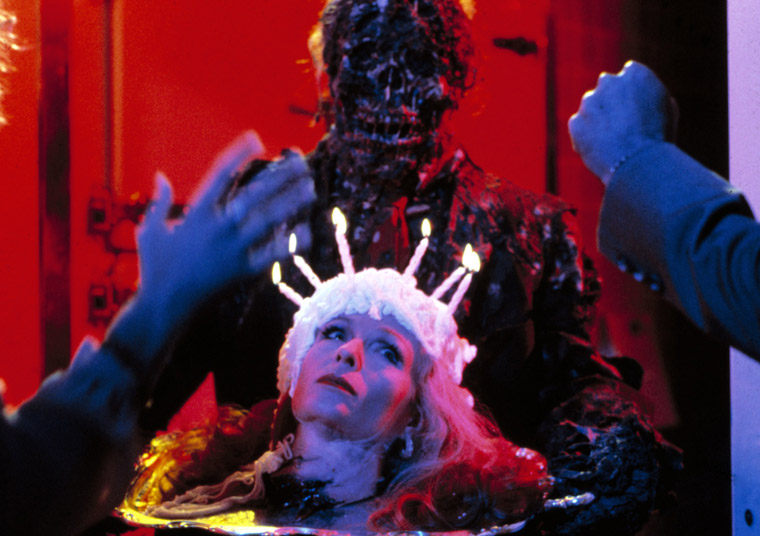Born to play Tennessee Williams, her harsh beauty, caustic humor and throaty tones were unmistakable and reminiscent of a bygone era that once idolized Tallulah Bankhead and Marlene Dietrich. Her old-fashioned stylings were perhaps too theatrical or indulgent to make a noticeable dent on film or TV (such was the case of Bankhead) but perhaps Hollyw...
Show more »
Born to play Tennessee Williams, her harsh beauty, caustic humor and throaty tones were unmistakable and reminiscent of a bygone era that once idolized Tallulah Bankhead and Marlene Dietrich. Her old-fashioned stylings were perhaps too theatrical or indulgent to make a noticeable dent on film or TV (such was the case of Bankhead) but perhaps Hollywood was the one who lost out on what could have been a wonderfully flamboyant character actress. In any event, actress Carrie Nye belonged to the stage and in return it embraced her for four decades.The smoky seductress was born in Mississippi with the highly untheatrical name of Carolyn Nye McGeoy on October 14, 1936 (some sources indicate 1937), the daughter of a banker and a housewife. She began her adult studies at Stephens College in Columbia, Missouri, but wound up at the Yale School of Drama where she met the equally droll but less acerbic wit Dick Cavett. The couple married in 1964. It was one of those unique, complimentary pairings, like Mel Brooks and Anne Bancroft, that withstood the test of time. Cavett was not a comedian then but actively pursuing a legit acting career. Dick and Carrie subsequently went on to perform together in such plays as "Charley's Aunt," "Auntie Mame," "The Brothers Karamazov," "The Skin of Our Teeth" and "Present Laughter" before he altered the course of his career.Acting professionally from the age of 14, Carrie played all the cherished Southern belle roles (Maggie in "Cat on a Hot Tin Roof" (1958), Cherie in "Bus Stop" (1958) and Blanche (at age 23!) in "A Streetcar Named Desire" (1959)) before making her Broadway debut in "A Second String" (based on a novel by Colette) at the Eugene O'Neill Theatre in 1960. From there she sunk her teeth into the classics. Notable roles included her title character in "Ondine," Celia in "As You Like It," Lady Macduff (and later Lady Macbeth) in "Macbeth," Cressida in "Troilus and Cressida," Regan in "King Lear," Cleopatra in "Antony and Cleopatra" and Cassandra in "The Trojan Women." On the lighter side, she replaced Betsy von Furstenberg in the popular lightweight comedy "Mary, Mary" and played Cecily Cardew in "The Importance of Being Earnest." In addition, she received a Tony nomination for her work in the musical "Half a Sixpence" in 1965.She didn't make her film debut until age 30 in The Group (1966), then went on to make only a handful more -- The Seduction of Joe Tynan (1979), Creepshow (1982), Too Scared to Scream (1985) and Hello Again (1987). She fared somewhat better in TV-movies, stealing the thunder from under the Richard Burton/Elizabeth Taylor pairing in Divorce His - Divorce Hers (1973), and earning an Emmy nomination for her divine imitation of Bankhead in The Scarlett O'Hara War (1980), which only she could have done true justice.But for Carrie it was always the theater, particularly regional theater, that took precedence. With a non-concentric and powerful grandeur, she took on a number of lofty roles over the years, including her Eleanor of Acquitaine in "The Lion in Winter," Regina in "The Little Foxes," the title role in "Hedda Gabler" and an encore performance of Blanche DuBois in 1973, this time at age 47. She earned a Drama Desk nomination for "The Man Who Came to Dinner" in 1980 and played alongside Cavett again in a 1985 production of "Nude with Violin." Throughout it all, Carrie was an established presence at the Williamstown Festival appearing from the late 50s on. Such summer productions there included "Design for Living" (1977) and "Clothes for a Summer Hotel (1989), taking her final curtain there in the role of Zelda Fitzgerald. She ended her theatrical reign on a bright note in a musical production of "Mame" (1992).Carrie pretty much left acting by the mid 1990s. In 2003, however, she took on a villainess role written especially for her on The Guiding Light (1952). In 1997, the couple's Long Island home (called Tick Hall) went down in flames. They painstakingly rebuilt an exact replica of the beloved 1883 cottage, which was chronicled in the documentary "From the Ashes: The Life and Times of Tick Hall (2003)".A heavy smoker, Carrie died of lung cancer at age 69 in her Manhattan home. The couple had no children.
Show less «



